By Víctor Rodríguez Velázquez
Versión en español aquí.
QUEBRADILLAS, PUERTO RICO — “There hasn’t been a drop of water for three days.” Cruz Pérez-Cabrera, 75, and her husband Paulino Vega-Román, 83, survive the consequences of water rationing on a daily basis in the Charcas de Quebradillas neighborhood.
Although the couple lives seven miles from the Guajataca reservoir, one of Puerto Rico’s largest, over the past two months they have had to store water in uncovered paint buckets and plastic gallons to supply all their daily needs.
“It is very difficult to be carrying water. “My arms cannot take it anymore,” the old woman added as she squeezed her right shoulder.
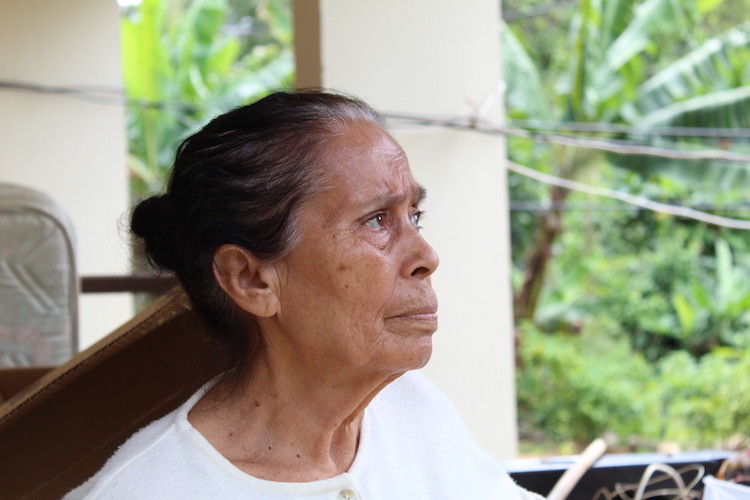

Cruz Pérez Cabrera narrates the struggle her family goes through to store water for the basic needs in their home. (Photo by Víctor Rodríguez Velázquez | Centro de Periodismo Investigativo)
The hurdles the couple suffers, along with more than 200,000 people who get their water from the Guajataca reservoir in northwestern Puerto Rico —affected by water rationing two months ago— were induced by the government, an investigation by the Center for Investigative Journalism (CPI, by its initials in Spanish) found.
In November 2018, two months before authorities announced the rationing, hydrologist Ferdinand Quiñones, an expert hired by the Puerto Rico Aqueduct and Sewer Authority (PRASA) to assess the state of the reservoirs after Hurricane María in 2017, warned that the Puerto Rico Electric Power Authority (PREPA),—which manages Guajataca— should reduce the amount of water discharging into the river due to the decrease in rainfall that became noticeable at the end of 2018. The U.S. Corps of Engineers, which has been repairing the reservoir after Hurricane María, was copied in the letter.
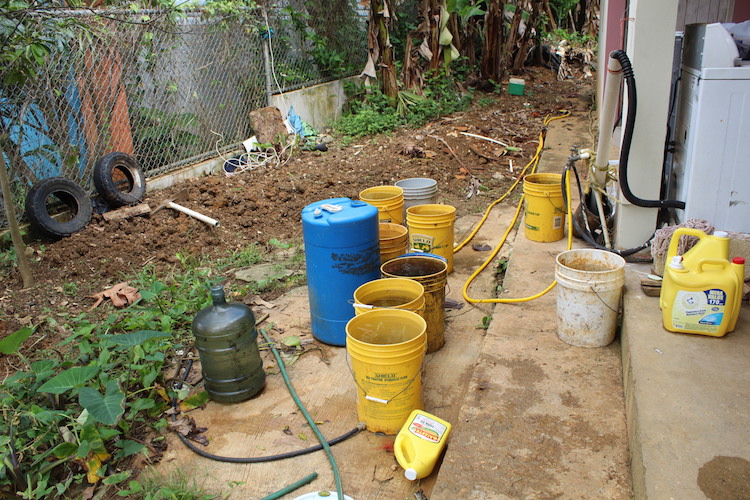

Pérez Cabrera and her husband have been filling different types of containers for two months to have water in their house in Quebradillas. (Photo by Víctor Rodríguez Velázquez | Centro de Periodismo Investigativo)
However, PREPA ignored the warning and continued to dump almost twice as much water as recommended by Quiñones and PRASA. The situation lasted until February 7, when PREPA shut off the tap, but it was too late. On February 22, barely two days before the rationing began, the discharge flow finally reached the 33 cubic feet the expert originally recommended.
PREPA Executive Director José Ortiz, said he was unaware about Quiñones’ warning and evaded answering other CPI questions about the alert.
However, the CPI confirmed with people close to the PRASA operation, who requested anonymity because they are not authorized to make public statements, that it was not until February that Gov. Ricardo Rosselló ordered to stop the discharge after PRASA Executive Director Elí Díaz, brought the claim to his attention. Rosselló did not grant an interview on the matter, although it had been requested since November 2018. He also did not answer questions from the CPI that were sent via email. The CPI asked PRASA for a copy of all communications exchanges with PREPA about the matter and the documents were not provided.
Ortiz denied that he had received instructions from the governor and claimed that Guajataca has been controlled by the U.S. Corps of Engineers since 2017.
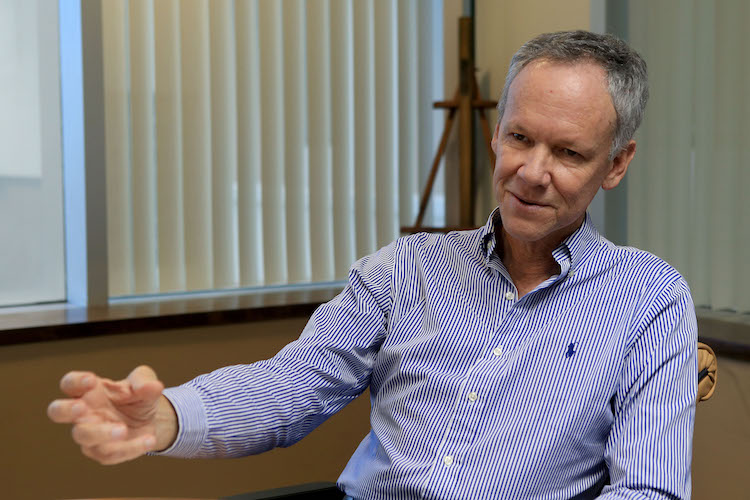

José Ortiz, PREPA’s executive director (Photo by Gabriel López Albarrán | Centro de Periodismo Investigativo)
Quiñones denounced that the lack of leadership related to Guajataca led to the water rationing in the area due to “the U.S. Corp of Engineers and PREPA’s negligence.”
“I said [to the U.S. Corps of Engineers] that the outflow could not go on. Now they have to ration due to the lack of control in the reservoir,” the hydrologist said.
Félix Aponte-Ortiz, a planner and member of the PRASA Governing Board, agreed that the government was slow to take action.
“I started to be concerned in January. Seeing the decline in Guajataca, I asked PRASA’s Vice President of Operations [Doriel Pagán] about it. I told her I noticed that it wasn’t raining much and that extraordinary measures would be needed at the lake at some point,” he said.
The dynamics, which has left seven municipalities without constant drinking water service, is only the latest in a pattern of neglect, lack of foresight and inaction on the part of the government of Puerto Rico given the drought pattern brought on by the looming climate change over the Caribbean, the CPI found.
Although Puerto Rico suffered the impact of Hurricane María in 2017, which caused the rivers to drag sediments to the reservoirs, almost two years later PRASA has not yet carried out the corresponding studies (called bathymetries) to learn how the dams were impacted. In fact, according to aquatic ecosystems expert José Ortiz-Zayas, it has been 15 years since the government last conducted bathymetries on all reservoirs, so the current capacity of these reserves is unknown.
PRASA manages the impact of the hurricane on the reservoirs from a mathematical projection made by Quiñones, in which he estimated the amount of sediment that the rivers may have dragged from the rains the hurricane brought and the landslides they caused.
This lack of knowledge poses a challenge given the changes in rainfall that are expected for the Caribbean. In 2018, the Intergovernmental Panel on Climate Change (IPCC) warned in a report that tropical zones will have longer dry spells and more intense, but shorter periods of rain.
That is to say, in Puerto Rico, the main problem is not the lack of rain, but the extreme variability with which this resource will arrive. Added to this is the government’s inability to properly store and distribute water, according to experts interviewed by the CPI. Data from the National Meteorology Service reveal that the accumulated precipitation for Puerto Rico has remained constant during the past six decades.
For Félix Aponte-González, member of the Drought Committee that advises the government, the country faces the need to identify intelligent and sustainable ways of collecting and storing rainwater, as well as the protection of underground sources.
Costly dredging, for example, does not add substantial supply to reserves. According to experts, there are modern options to solve the problem of sedimentation such as filtering the water before it reaches the reservoirs and creating reservoirs outside the waterway.
All these possibilities are on the desk of the PRASA chief. However, it is not yet clear how he will address the sediment problem.
“We have people who tell us that there shouldn’t be major dredges, but rather ongoing ones. Others say that you have to play with the system so that the sediment is released on its own. There are elements that we have to discuss, such as where we are going to deposit the material. We’re in discussions with the DNER. Unfortunately, there is a lot of garbage [in the reservoirs],” Díaz admitted.
Compounded with the inaction after the passage of the hurricane is the fragmentation of responsibilities among different public agencies, the bad state of the pipes that causes the loss of 53% of the water that is produced, uncontrolled commercial and agricultural extraction, the contamination of aquifers (as is the case of the southeast by AES) and the reduced capacity in reservoirs due to lack of maintenance, several experts agreed.
The panorama is also affected by the uncertainty related to the future of 17 dams and reservoirs used for power generation and irrigation —among them, Guajataca— that belong to PREPA, given its imminent privatization. None of the legislators and officials interviewed could say what will happen to these drinking water sources and their maintenance when the public corporation passes into private hands.
In the opinion of five experts interviewed, the government negligently handles the conservation, reserve and distribution of water in Puerto Rico.
PRASA Has No Control Over Reservoirs
The executive director of PRASA told the CPI that his role in Guajataca is limited to a “client” relationship with PREPA, without any interference in the decision-making process for the management of the dam.
“Hey, everything was controlled by PREPA. We drink water from what is in the irrigation channel. Our operation starts with some irrigation pumps in different points of that channel that lead to our plants,” the official said.
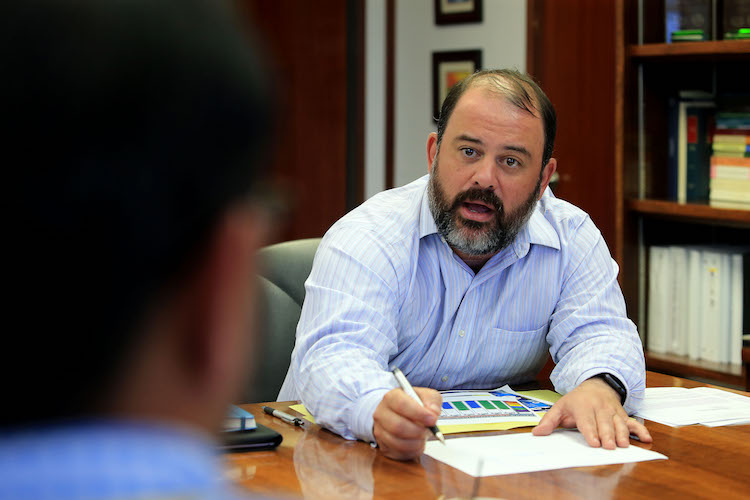

Elí Díaz Atienza, PRASA’s executive director, acknowledged that there are unexplored alternatives for reservoir dredging. (Photo by Gabriel López Albarrán | Centro de Periodismo Investigativo)
Guajataca has two routes for the flow of water: one through a spillway that guides the liquid to the river and the other, through an irrigation channel that supplies PRASA.
During the passage of Hurricane María, the Guajataca reservoir overflowed the spillway, overpassing the PR-111 road that runs over the dam. According to Quiñones, this uncontrolled overflow induced the erosion of the lower part of this exhaust system. Faced with the failure, the U.S. Corps of Engineers assumed control of the dam and ordered the eviction of some 50 adjacent houses and of residents of the Isabela and Quebradillas urban centers.
On November 20, 2017, the U.S. Corps of Engineers completed the first phase of the repair work to avoid “any threat of flooding.” As of that date, the federal agency asked PREPA to lower the level of the reservoir below 194 cubic meters. The U.S. Corps of Engineers said in written statements to the CPI that the request was to “protect the lives of construction workers” in case some rain caused a flood from the Guajataca River, which flows from Lares and passes through the reservoir.
Quiñones, who for 28 years worked for the U.S. Geological Survey (USGS), maintains that the U.S. Corp of Engineers did not adequately calculate rainfall, since the chances of a flood between December and March —a traditionally dry season— “are almost zero.”
The USGS rainfall monitoring system shows a significant decrease in the inches of rainfall that the Guajataca River received between August and December 2018. In August, it received 14 inches of rain. However, in December it barely received half an inch.
PRASA insists that it warned about it. According to Díaz, during “meetings with PREPA and the U.S. Corp of Engineers, PRASA expressed its concern about the drop in levels due to the low precipitation period that always takes place from December to May.”
In spite PRASA’s of predictions and warnings, PREPA continued with the same discharge levels.
“I know that at one point there were people who brought up a concern that water was being thrown away… and the engineers were told: ‘Look, let’s protect the reservoir’s water levels’,” Díaz acknowledged.
How did the U.S. Corp of Engineers react to these requests? the CPI asked.
“That’s something you should talk about with PREPA, which works directly [with the U.S. Corp of Engineers], because the task order put them in charge of that situation. I know there may have also been —I don’t remember well— a discussion with DNER about the flow of water. But that was controlled by PREPA,” the official said.
However, the PREPA director avoided taking responsibility for the decision even though the agency owns the dam. In a brief interview, he contradicted himself by first saying that the control of the reservoir is held by the U.S. Corp of Engineers, and then that he acted in accordance with the federal agency.
“The U.S. Corp of Engineers is the one that has control over what is done there. Something that cannot be put into play is the integrity of the dam, which could cause a loss of life. What was done was with the consent of the U.S. Corp of Engineers,” said Ortiz.
Despite Water Act, DNER Secretary Washes Her Hands
For her part, the Secretary of the Department of Natural and Environmental Resources (DNER), Tania Vázquez, assured that her agency does not interfere in the determinations that each reservoir administrator makes. She said her role is limited to conducting the corresponding studies on the country’s hydrological cycles and alert the governor when there is any variation, such as a drop in rain levels.
“I don’t monitor whether water reaches your house. That’s not my jurisdiction, that’s up to them [PRASA]. What we did say at one point is that they had to lower [the amount of water discharged] in a gradual way to avoid the impact to aquatic life there,” she said.
Her opinion is contrary to the role required by the Conservation, Development and Use of the Puerto Rico Water Resource Act to “protect the country against the adversities of scarcity, misuse, waste, and the contamination of such an essential resource, as well as making its use compatible with the physical-natural realities in that it is located and with the country’s social and economic needs.” (Article 2, Act 136 of 1976).
Furthermore, the Water Act also empowers the DNER to “adopt the regulations it deems necessary on uses and areas of use of water bodies, the flow that may be used from each body, forestation of river areas, rivers, lakes, lagoons and dams, claiming of lands, rescue of flooded areas, and other aspects related to waters.”
At Least Nine Years of Possible Rationing Due the Guajataca Repair
Even if it rains in Guajataca, the reservoir management problem is subject to the work of the U.S. Corp of Engineers, which could take up to nine years.
Engineer José Bermúdez, head of the division of irrigation, dams and reservoirs for PREPA, explained that only the first of three phases of reconstruction work has been completed in Guajataca. He said the second phase, which began in January this year, should end in May. The third phase, the official added, would include a process of research, design and implementation of new technologies in the reservoir.
He estimated that the project will end in 2028. According to Bermúdez, during that time, Guajataca would operate with a restricted water level. In that case, PRASA would be forced to maintain operational adjustments for up to nine years, exposing itself to new water rationing in times of drought.
“The restrictions in the reservoirs are made to maintain the safety of the reservoir. The restriction of any reservoir goes beyond the availability of water,” Bermúdez argued.
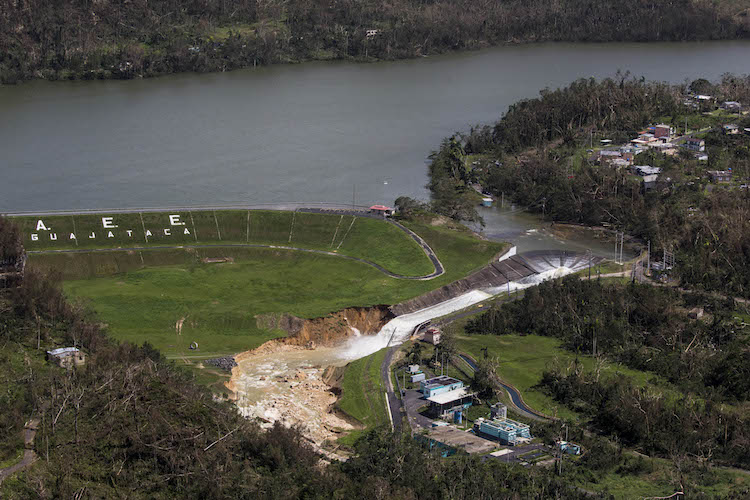

During Hurricane María, the Guajataca reservoir overflowed the spillway. This image was taken on September 23, 2017. (Photo by Dennis Rivera | Centro de Periodismo Investigativo)
The engineer explained that this conclusion responds to a security protocol agreed to between the U.S. Corp of Engineers and the Dams Inspection Unit, which is part of the division he directs. However, the CPI requested a copy of that protocol and the names of the U.S. Corp of Engineers officials with whom that determination was agreed, but Bermúdez did not provide them.
The official claimed that it was conversations with various experts and that the final decision was covered by the State Program of Dams and Reservoirs Inspection and Regulation Act (Act 133 of 1986) that gives power to PREPA’s executive director to adopt a plan of measures to be taken when “a dam or reservoir of an agency or public instrumentality shows danger to the life and property of the citizens in the area in which it is located.” (Article 6, Act 133 of 1986).
But if the dam had already been placed below what was required to maintain safety and it was not raining, why was the same discharge maintained? That is the equation that does not add up for area residents that since February 22 have been in a rationing plan. Sometimes, they run out of water for three straight days, although PRASA says it should be only for 12 hours a day.
To get to the Charcas de Quebradillas neighborhood, you have to go down several slopes. The sector has 105 houses —some abandoned— two churches and a Head Start, which closed last year.
More than 400 people live there. They spend at least 12 hours a day without water under the rationing plan. Several residents said the periods are longer.
Samuel Pérez-Ramos, 64, peeled pigeon peas on the balcony of the house where he lives with his mother Lorenza Reyes-Ramos, 84. He ran out of smiles. “It’s been three days without water and, when it arrives, it comes without any pressure because of a broken pipe that has been like that for three months,” he explained as he pointed toward a hill. Pérez-Ramos attributes the rationing he suffers to the broken pipe, not to the drought.
The Quebradillas native’s main concern is that when it returns to “normal,” PRASA will charge them for “that water that has been lost” through the pipe.
His neighbor, Felix Ramos, a builder by profession, complained that the lack of water extends for so long and that no one has explained the reasons.
René Muñiz, 56, and another resident of the Charcas neighborhood, is concerned about the vulnerability of his neighbors: “Most of the people who live here are older. And if they dried up the lake to be able to work, nobody has come here to explain it to them,” the construction worker said.
Bermúdez acknowledged the inconvenience of the rationing but reiterated that these are situations caused by “the development of the Guajataca project until its completion.”
For planner Aponte-Ortiz, the new reality in Guajataca responds to a bad coincidence of drought and structural problems that will worsen with the shortage of rain throughout the year.
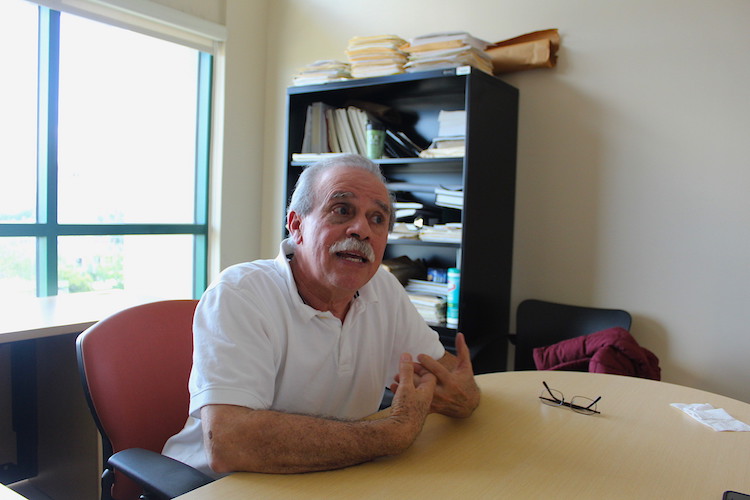

Félix Aponte-Ortiz. (Photo by Víctor Rodríguez Velázquez | Centro de Periodismo Investigativo)
He demanded an “external forensic audit” from the PRASA Governing Board to understand what caused the dam failure and why it has taken so long to solve it.
PREPA Privatization Puts Matters in Check
Aponte-Ortiz foresees a change in the water storage and distribution culture from Guajataca. But PREPA’s ongoing privatization process brings to the discussion where Guajataca and the other 16 reservoirs and dams that PREPA manages will end up.
As part of the privatization, Senators Larry Seilhamer, of the New Progressive Party (PNP), and Eduardo Bhatia, of the Popular Democratic Party (PPD), promoted the regulatory framework that will guide the process of selling the corporation’s assets through Senate Bill 1121, which the governor signed into law on April 11. The latest version of the bill, however, did not address the future of water dams and power generation that PREPA manages.
Seilhamer admitted to the CPI that he had not thought about the possibility of selling those assets during the process of drafting the bill but stressed that the sale will focus only on the generation and distribution plants.
“What is happening is that [the reservoirs] are not generating significant electricity. I do not see them included in what is going to be transferred to the private sector. Nor would they be excluded, because they are active. There is a great debate on whether to move them to PRASA,” said the PNP legislator.
Currently, only nine of PREPA’s 17 dams are dedicated to energy generation. Together, they all provide around 11,574.2 megawatts, according to engineer Bermúdez. Of those that generate energy, PRASA filters water from Caonillas in Utuado.
PREPA’s executive director shares the opinion that PRASA should take control of the reservoirs that PREPA currently manages.
“Since 2010, I have been talking about the fact that those reservoirs should go to PRASA because those reservoirs that provide water to Puerto Rico must be kept out of private hands. That is not negotiable,” said Ortiz.
But does PRASA have the economic capacity to take them over? the CPI asked.
“If PRASA generates its own energy, it would have some savings that could be used to maintain these reservoirs,” he said.
But that is an unspoken subject at PRASA. The agency’s executive director is also chairman of PREPA’s Governing Board. Díaz avoided answering questions about the possible sale of reservoirs as part of the energy model that is to be promoted in the country.
“I prefer not to go into the subject to avoid conflict and keep up the processes with bondholders. I am restraining myself from going into subjects that have to do with PRASA and PREPA. I think PREPA will have a plan for that [the reservoirs],” he said.
Bhatia, however, said he sees no problem with the fact that PREPA dams are privatized. He also doesn’t worry about whether PRASA becomes a client of a private company that is interested in managing some of these dams.
What would happen if these reservoirs are sold? Would PRASA become a client of that private provider?, the CPI asked Bhatia.
“Yes. And let them pay what they have to pay. We have to clean up the finances. What cannot happen is that we continue to subsidize each other in a lie that leads to PREPA’s failure and for PRASA to be operating inefficiently,” Bhatia emphasized.
On the other hand, Drought Committee planner Aponte-González views the argument with suspicion. The expert criticized that they would want to traffic with water from the private sector, since the resource is protected as a public good since 1976, when the Water Act was passed.
“You have to ask yourself if what is to be sold is the infrastructure or the resource. The resource must remain a public good,” Aponte-González said.
The Secretary of Natural and Environmental Resources washed her hands of any action taken with the reservoirs that PREPA manages during the process of selling the corporation’s assets.
“Although I [the DNER] monitor aquatic life there, that is a lake that is created artificially and used for water supply. My jurisdiction there is limited. Obviously, it is water that comes from the rivers, but it is a lake that was not there; it was created. For that reason, it is the responsibility [of the dam’s] administrator,” said Vázquez.
However, the Water Act of 1976, amended in 2006, establishes that the DNER is the entity designated by the government to administer and protect the water resource as patrimony of the Puerto Rican people. The statute requires as public policy that water be distributed equitably and fairly.
It also establishes that “water needs related to domestic consumption, and particularly to human consumption, should be met with priority above any other” and that “in the allocation of the available surplus, the public interest should prevail over all other interests or claims.”
***
This report is part of the Se seca el Caribe (The Drying Caribbean) series, the result of the work of a dozen Caribbean journalists led by the Puerto Rico’s Centro de Periodisimo Investigativo. The investigations were possible in part with the support of Para la Naturaleza, Fundación Segarra Boerman e Hijos, and Open Society Foundations.


